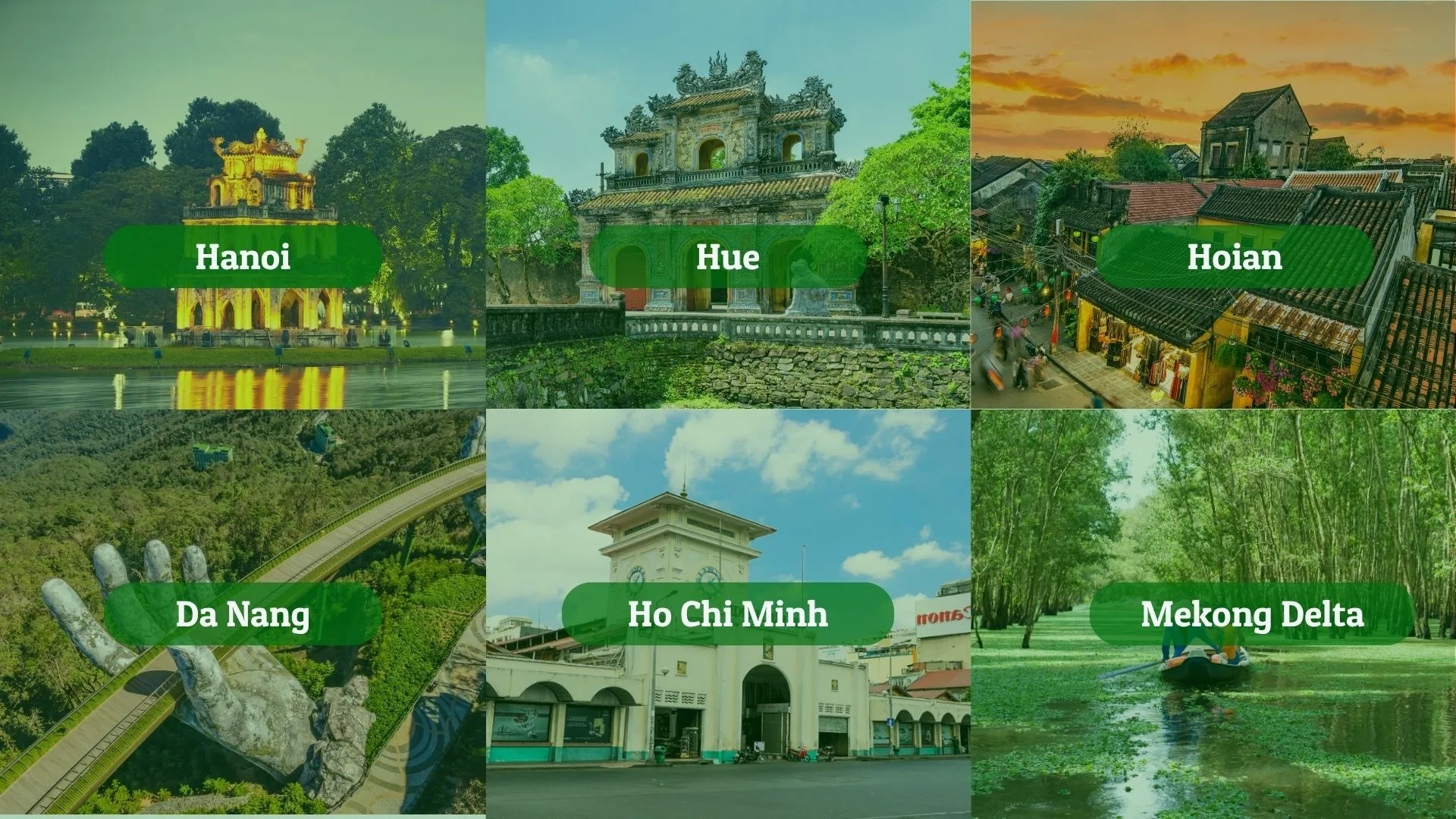 Email: support@vespaagogo.com
Email: support@vespaagogo.comVietnam Travel
- Home
- Travel Tips
Vietnam Raining Season Guide: When to Go & What to Expect
2025-09-30
You’ve just pulled up the weather forecast for your dream trip to Vietnam, and your heart plummets. A solid week of thunderstorm icons stares back at you from the screen. That sinking feeling creeps in, doesn't it? The vision of sun-drenched beaches and azure skies seems to be dissolving into a puddle of disappointment.
But hold on. Take a deep, calming breath.
Choosing to travel during the Vietnam raining season isn’t a mistake; it's a strategic choice for the savvy traveler. For some destinations, admittedly, the rain is a formidable foe that can derail an entire itinerary. But for many others, it’s a coveted "special feature," a seasonal update that unlocks a more cinematic, atmospheric, and authentic version of the country. It’s a Vietnam with fewer crowds, lower prices, and experiences so unique they are simply unavailable during the sun-drenched peak season.
This comprehensive guide is designed to be your most trusted and honest advisor. We will move beyond simple suggestions and dive deep into the A-Z of rainy season travel. We'll meticulously analyze the pros and cons, classify destinations with a clear "Green Flag" (Go for it!) and "Red Flag" (Think twice!) system, provide an exhaustive packing and safety checklist, and detail hyper-specific itineraries and activities for each recommended location. Together, let's transform your weather-related anxiety into a masterfully crafted adventure plan.
Why Travel During Vietnam's Raining Season? A Brutally Honest Look at the Pros & Cons
Before packing your bags, it's crucial to weigh the scales. This isn't about ignoring the downsides; it's about understanding them and seeing if the incredible upsides are a worthy trade-off for you.
The 4 Golden Benefits You Can't Ignore
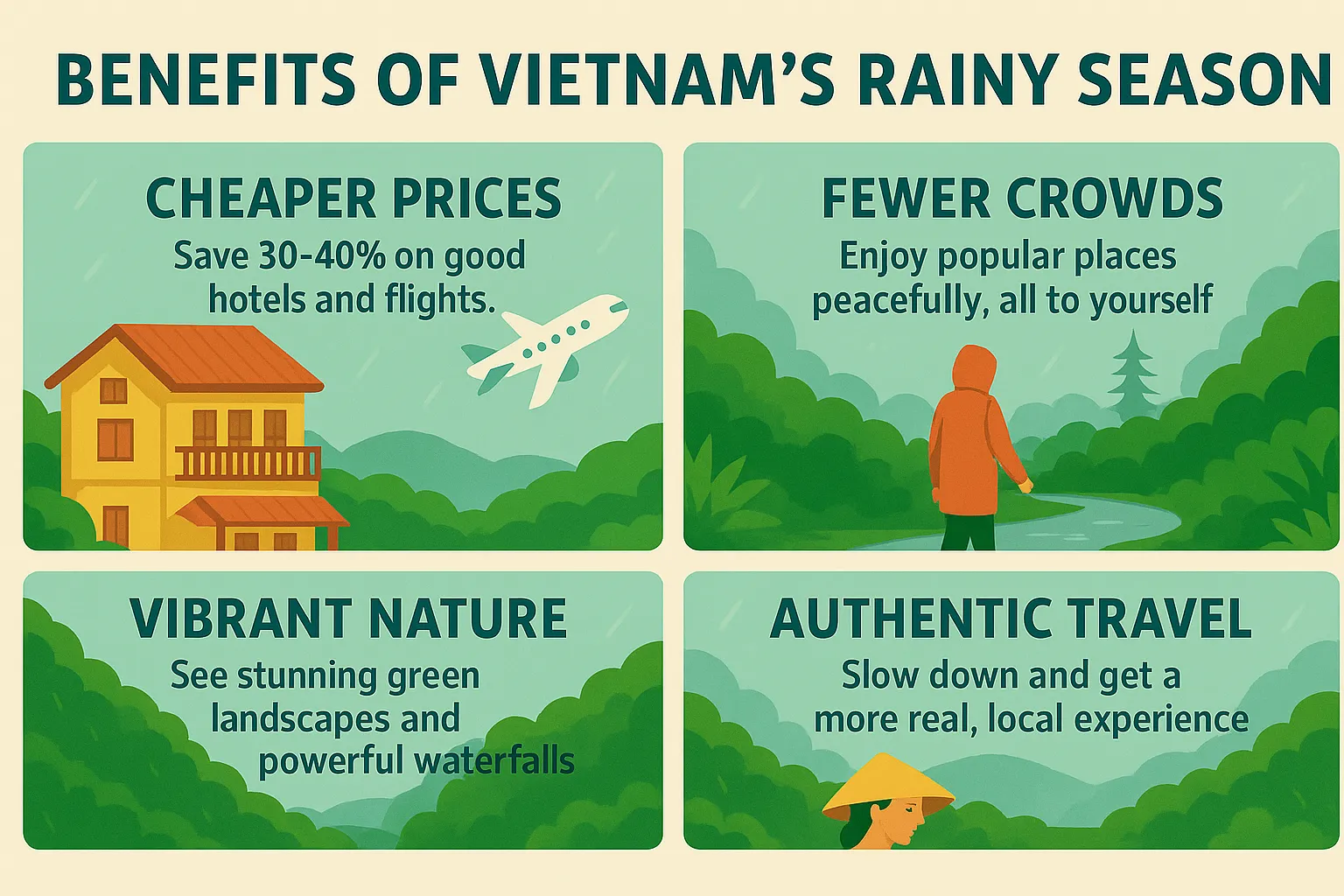
A radically more affordable trip
This is the most tangible benefit. During the wet season, tourism in Vietnam slows down, and prices plummet. A 5-star beachfront resort in Da Nang that might command $300/night in the peak of December could be available for $180 in October, and that boutique hotel in Hanoi's Old Quarter might drop its price by 30%.
Internal flights on airlines like VietJet Air or Bamboo Airways are also significantly cheaper, allowing you to explore more of the country for less. This is your chance to experience a level of luxury and comfort that might otherwise be out of reach.
A land of serenity and space
The biggest complaint about tourism hotspots globally is overcrowding; the rainy season is the antidote.
Imagine being one of only a handful of people exploring the sprawling ruins of the My Son Sanctuary, the mist giving the ancient temples an ethereal quality. Picture yourself sitting in a Hoi An teahouse with an uninterrupted view of the street, the only sound being the rain and the distant chatter of a shopkeeper.
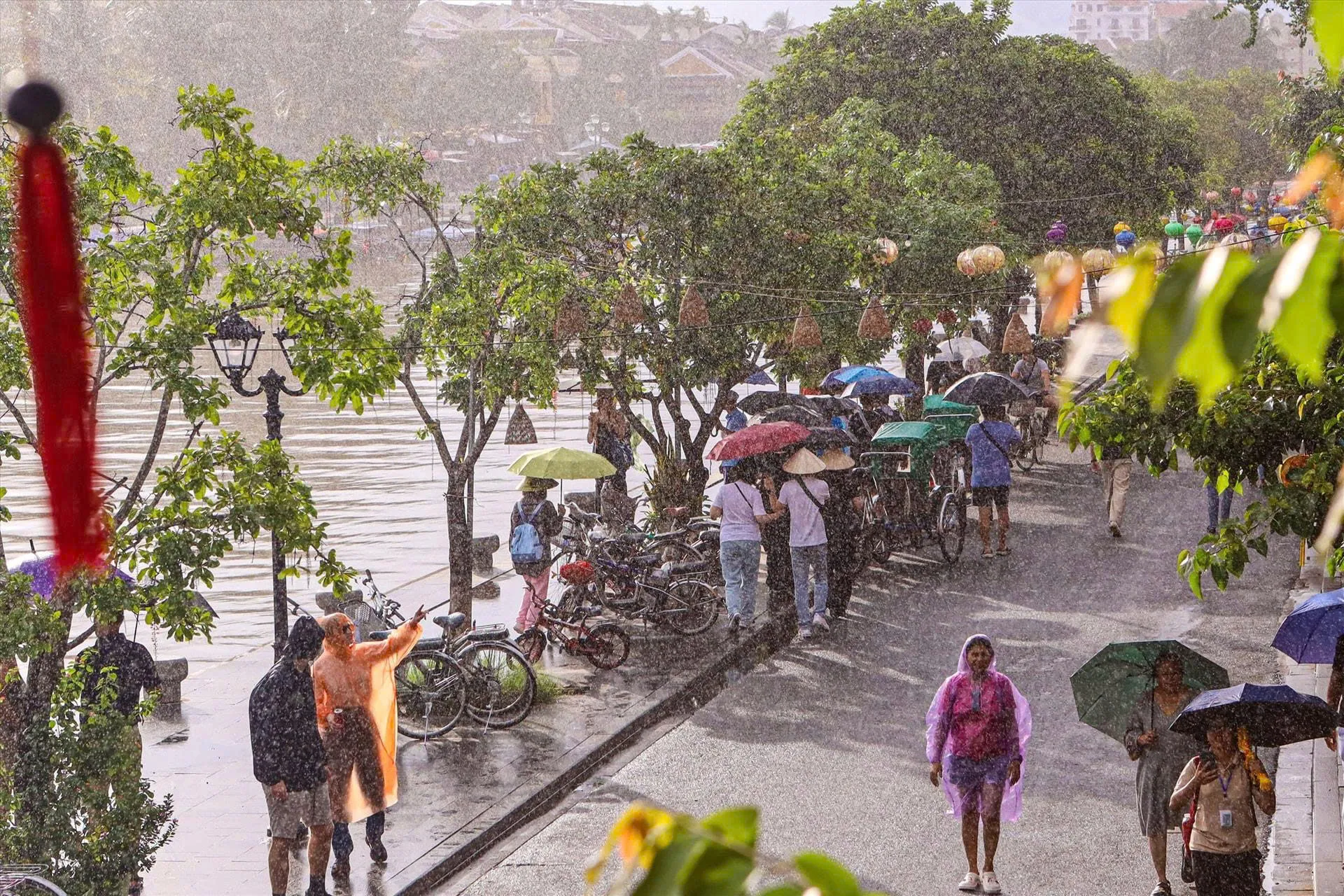
This is your opportunity to connect with Vietnam on a deeper level, to hear its stories without the distracting noise of a thousand other tourists.
Nature in hyper-vivid technicolor
Rain is life, and you see this truth everywhere you look. The iconic rice terraces of Sapa or Pu Luong, which can look dry and tired at other times of the year, explode into an impossible spectrum of emerald and jade, while the waterfalls around Da Lat, like Pongour and Elephant Falls, transform from gentle cascades into roaring, powerful spectacles.
The air itself feels cleaner, the dust settled, leaving behind a world that is vibrant, lush, and pulsing with vitality.
The gift of slow, authentic travel
A packed, sunny itinerary encourages a "checklist" mentality - a rush from site to site just to snap a photo and move on. The rain, however, forces you to slow down.
It gives you permission to spend three hours in a single café, not just for the coffee, but for conversation and people-watching. It encourages you to duck into a random art gallery, join an impromptu cooking class, or simply sit on your balcony and read a book.
These unplanned, quiet moments are often where the most profound and lasting travel memories are made.
The 3 Real Risks to Seriously Consider
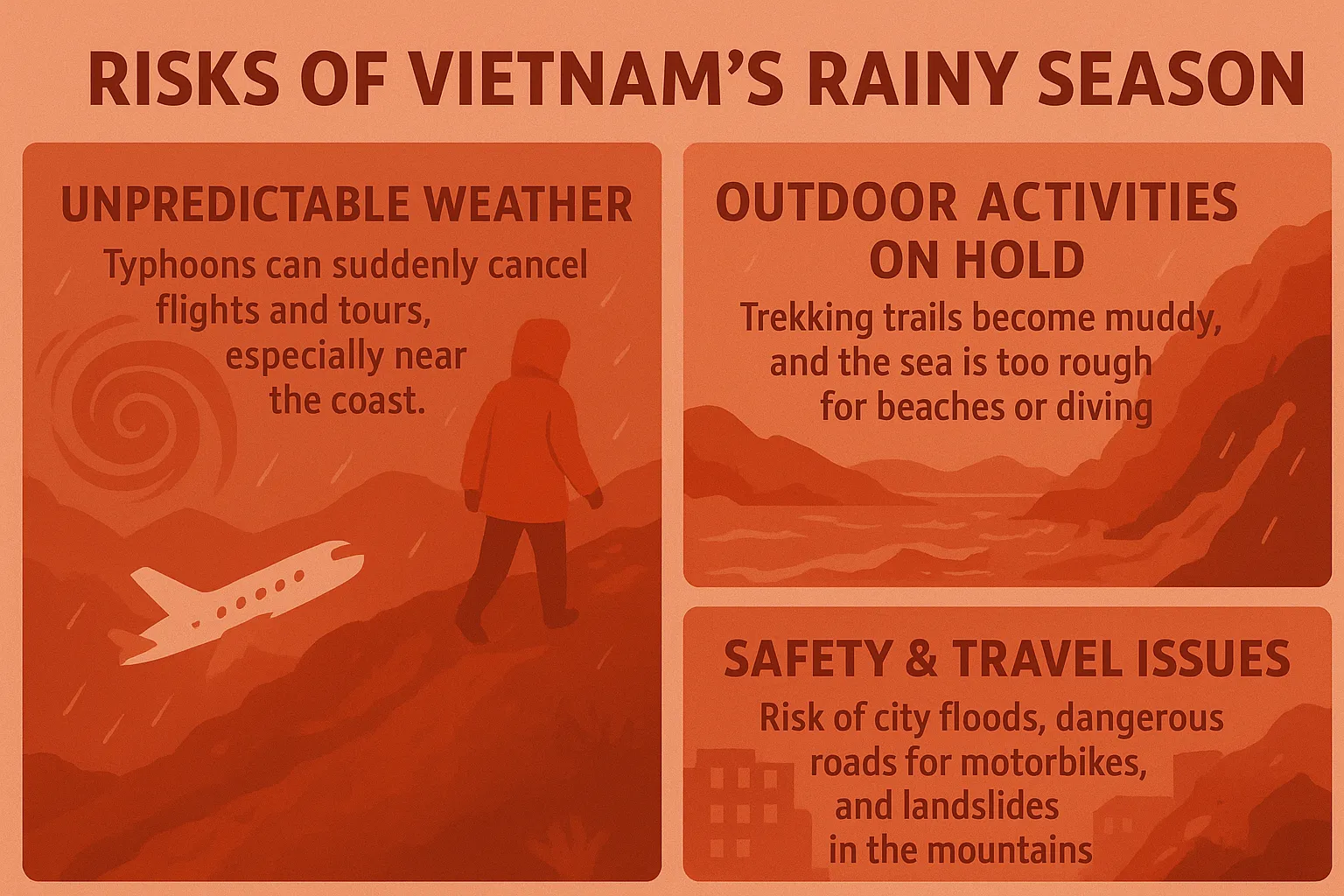
The Tyranny of Unpredictable Weather
Understanding when the rainy season in Vietnam is key to managing this risk, as the timing varies significantly by region: May to September in the North & South, but a later September to December season in the Center. A typhoon is a force of nature that respects no itinerary, and this is the biggest risk in coastal areas. The answer to what is the rainiest month in Vietnam also depends on your location; typhoon warnings are common in Central Vietnam during its peak wet months of October and November, while the North and South see the most rain in July and August.
In these conditions, flexibility is your greatest asset.
Outdoor adventures on hold
If your vision of Vietnam is trekking through remote mountain villages, sunbathing on pristine beaches, or scuba diving in crystal-clear water, the rainy season will likely be a disappointment.
Trails can become treacherous mudslides, the sea turns rough and murky, and many island tours are simply canceled. It's important to be honest with yourself about what your "must-do" activities are before you book.
Navigating safety and logistics
Travel logistics require more caution. If you're wondering "Are thunderstorms common in Vietnam?", the answer is a definitive yes. The typical pattern in Northern regions like Hanoi and Southern areas like Saigon is not an all-day drizzle, but short, intense downpours in the afternoon. The resulting heavy rain can cause significant temporary flooding in urban centers, making a simple Grab ride a complicated affair. In the northern mountains, the danger of landslides on winding roads is a serious, life-threatening risk that should not be underestimated.
On a personal level, riding a motorbike - a popular way to see the country - becomes exponentially more dangerous on slick, low-visibility roads.
Green Flag Destinations: Where the Rain is Part of the Magic in Vietnam
These are the locations where the rainy season experience is not a compromise, but a unique and wonderful adventure in its own right.
Hanoi: A Cinematic Ode to Northern Charm
Rainy season overview: May - September. The pattern is typically a hot, humid day followed by a dramatic, heavy, but relatively short downpour in the late afternoon.
Why you should go: The rain acts as a daily reset button, washing away the heat and grime, leaving the city glistening under the streetlights. It’s when Hanoi’s legendary café culture and soulful cuisine truly shine.
A perfect rainy day in Hanoi:
- Morning (9 AM - 12 PM): The mornings are often dry. Use this time to explore the Temple of Literature or walk around Hoan Kiem Lake before the heat and humidity peak.
- Afternoon (1 PM - 5 PM): As the clouds gather, it's time to head indoors. Your first stop is a deep dive into coffee culture. Skip the tourist traps and find a quiet, multi-story café like Cafe Giang for the original egg coffee or Loading T for a brew in a stunning French colonial building. Spent a couple of hours here. Afterwards, head to a museum. The Vietnamese Women's Museum is a world-class, deeply moving experience.
- Evening (6 PM onwards): The rain has passed, leaving the air cool. This is the perfect time for a food tour. Don't just eat -understand. Seek out a bowl of Phở Bò (beef noodle soup) on Bat Dan street, but also try the incredible Chả Cá Lã Vọng (grilled turmeric fish with dill), a dish unique to Hanoi. End the night with tickets to the Thang Long Water Puppet Theatre, a magical experience that is perfect for a post-rain evening.
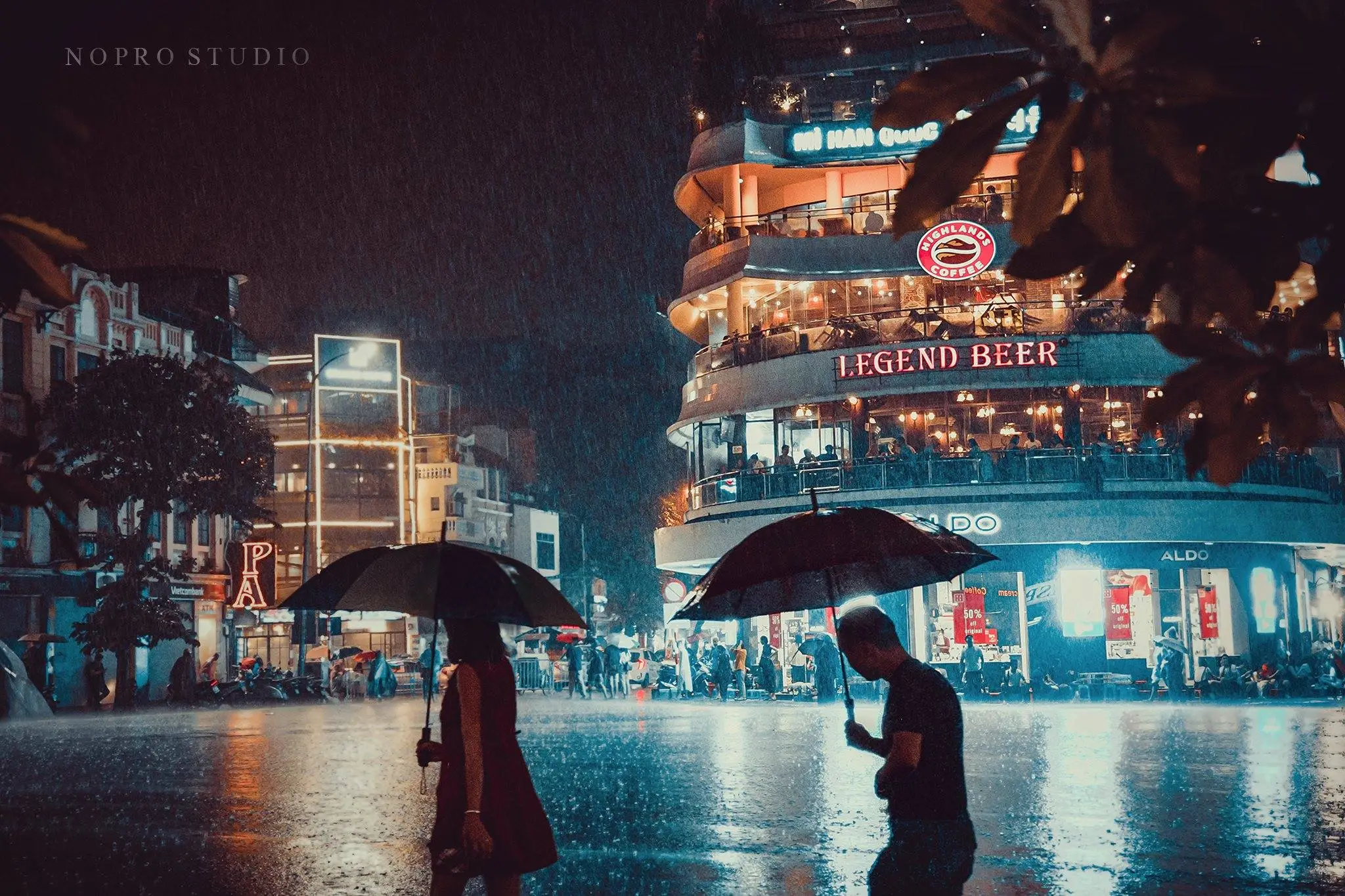
Hue: Where Melancholy Becomes Beautiful
Rainy season overview: September - December. The rain here is different -it's often a persistent, gentle, and cool drizzle, known locally as mưa dầm, that can last for days, creating a deeply atmospheric mood.
Why you should go: This weather is the perfect soundtrack for Hue's soul. The rain deepens the greens of the moss on the ancient citadel walls and lends a haunting beauty to the Perfume River, making the entire city feel like a living poem.
Foodie focus: what to eat when it rains in Hue:
- Bún Bò Huế: The city's signature dish. A spicy, rich beef noodle soup that is the ultimate soul-warming comfort food on a cool, drizzly day.
- Bánh Khoái: A crispy, savory pancake filled with pork and shrimp, served with a unique peanut dipping sauce. Perfect as a hot, satisfying snack.
- A Hotpot Feast: Gather with friends at a local restaurant for a steaming pot of seafood or beef hotpot (lẩu), a communal and warming experience.
Beyond the obvious: Instead of just visiting the Imperial City, find a guide to show you the smaller, quieter pagodas like Tu Hieu Pagoda, where you can hear the monks chanting, the sound mingling with the gentle rain. Visit An Dinh Palace, the beautifully restored private residence of the last emperors, to see a different side of royal life.
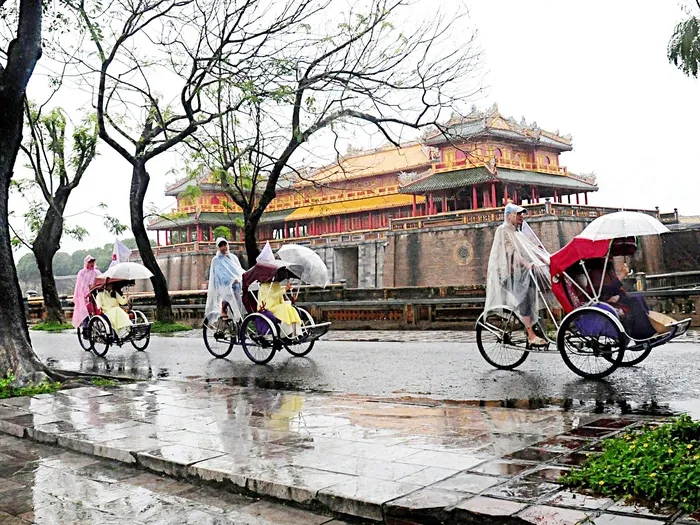
Da Nang: The Modern City's Rainy Day Resilience
Rainy season overview: September - December, with the heaviest downpours and highest typhoon risk from October to November.
Why you should go: Unlike the ancient towns, Da Nang's modern infrastructure handles the rain well. It’s a city that doesn't shut down. The rain washes the city clean, cools the air, and the long, empty stretches of My Khe Beach take on a dramatic, moody beauty perfect for contemplative walks. It's also the perfect central base for rainy-day trips to Hoi An or Hue.
A plan for a rainy day in Da Nang:
- A morning of ancient art: Spend your morning completely dry while exploring the world's most impressive collection of Cham artifacts at the Museum of Cham Sculpture. The beautiful French colonial building itself is a sight to behold.
- An indoor food adventure: For lunch, dive headfirst into the organized chaos of Con Market or Han Market. Navigate the indoor food courts and sample a huge variety of Da Nang specialties, from a steaming bowl of Mì Quảng (Quang-style noodles) to fresh bánh xèo (crispy pancakes).
- Cafe hopping with a view: Da Nang's cafe scene is incredible. Find a chic cafe along the Han River to watch the city go by, or choose one with a view of the stormy sea. It’s the perfect way to spend a rainy afternoon.
- Weekend spectacle: Don't let the rain stop you from seeing the famous Dragon Bridge breathe fire and spit water on Saturday and Sunday nights at 9 PM. The spectacle is arguably even more impressive against a dark, rainy sky.
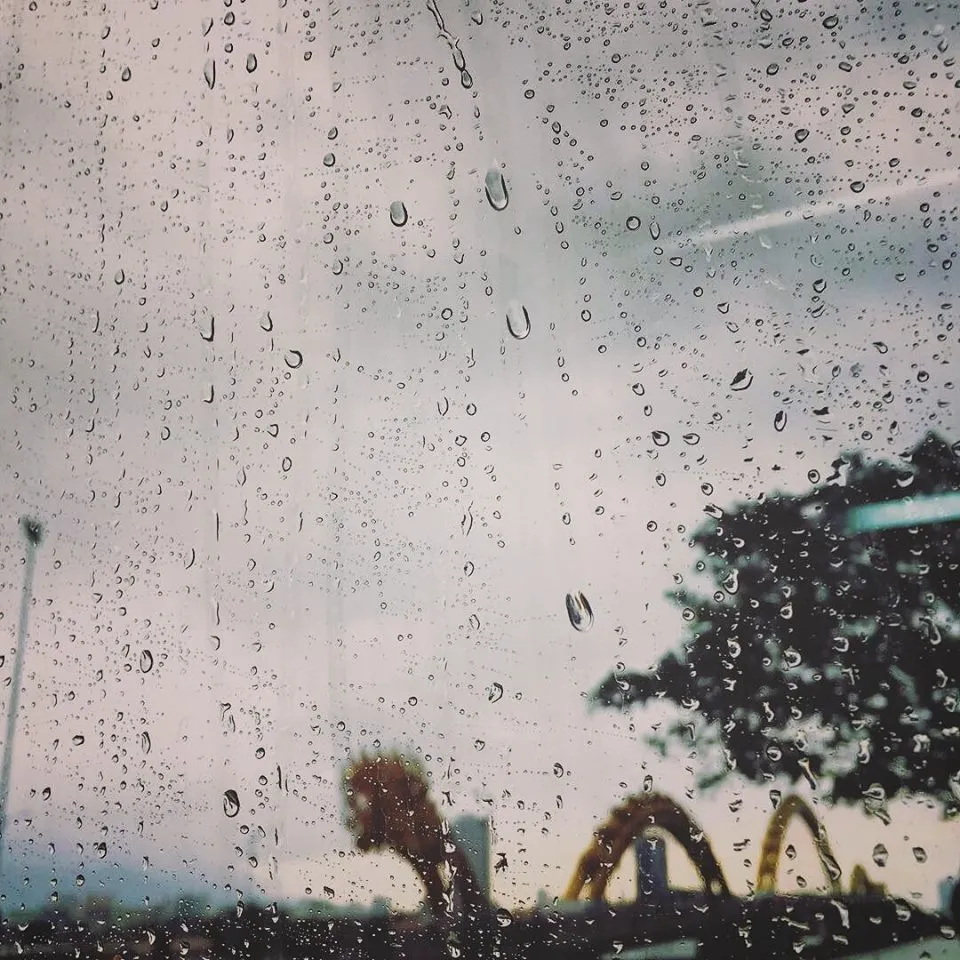
Hoi An: A Shimmering Lantern-Lit Dreamscape
Rainy season overview: September - December. Expect afternoon showers, and be aware that during heavy rains (especially in October/November), the river can swell, causing charming but inconvenient flooding in the Old Town.
Why you should go: The rain transforms Hoi An. The iconic yellow walls of the ancient houses take on a deeper, richer hue. At night, the thousands of silk lanterns don't just glow; they reflect and dance on the wet cobblestone streets, creating a scene of breathtaking, romantic beauty.
A perfect rainy day in Hoi An:
- Morning (9 AM - 1 PM): Start your day at a tailor shop. The process of choosing fabrics, patterns, and getting measured is a fun, creative, and quintessentially Hoi An experience that can take a few hours -perfect for a rainy morning.
- Afternoon (1 PM - 5 PM): After lunch, immerse yourself in a hands-on workshop. The Hoi An Lantern Making Class is a classic, but also consider a wood carving workshop or a cooking class at the renowned Red Bridge Cooking School. You’ll stay dry, learn a skill, and create a meaningful souvenir.
- Evening (6 PM onwards): The rain often subsides by evening. This is when the magic happens. Find a second-story café, like Faifo Coffee, for its famous rooftop view over the lantern-lit town. Then, simply wander. With fewer people, you can take incredible photos of the shimmering reflections. If the town is slightly flooded, you might even get to experience the surreal "boat ride through the streets."
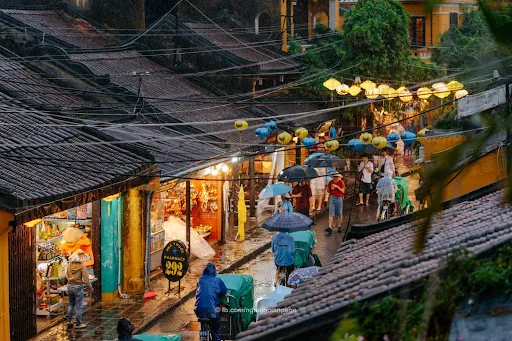
Saigon (Ho Chi Minh City): The Predictable Urban Downpour
Rainy season overview: May - November. Saigon's rain is famous for its punctuality. Almost like clockwork, a dramatic, torrential downpour will hit the city between 2 PM and 5 PM, last for an hour or two, and then vanish.
Why you should go: The rain is simply part of the city's daily rhythm. It's an event. The city has a whole culture built around it, and it provides a welcome, cooling break from the relentless tropical heat.
Beyond the obvious: Everyone visits the War Remnants Museum. For a different rainy day experience, visit the Ho Chi Minh City Museum of Fine Arts, housed in a stunning colonial-era mansion. Or explore "Antique Street" (Le Cong Kieu), a small road packed with shops full of fascinating historical treasures -a perfect place to get lost for an hour.
Embracing the night: After the rain cools the city, the nightlife awakens. For an unparalleled local experience, a Vespa A Go Go tour is a must. The "Eat Saigon" tour is a fantastic introduction, mixing delicious street food with a final stop at a stylish rooftop bar. For a deeper dive into the local scene, the "Dining Delights" takes you to the hidden-gem restaurants and lively venues where young Saigonese actually hang out, offering an authentic, high-energy slice of city life.
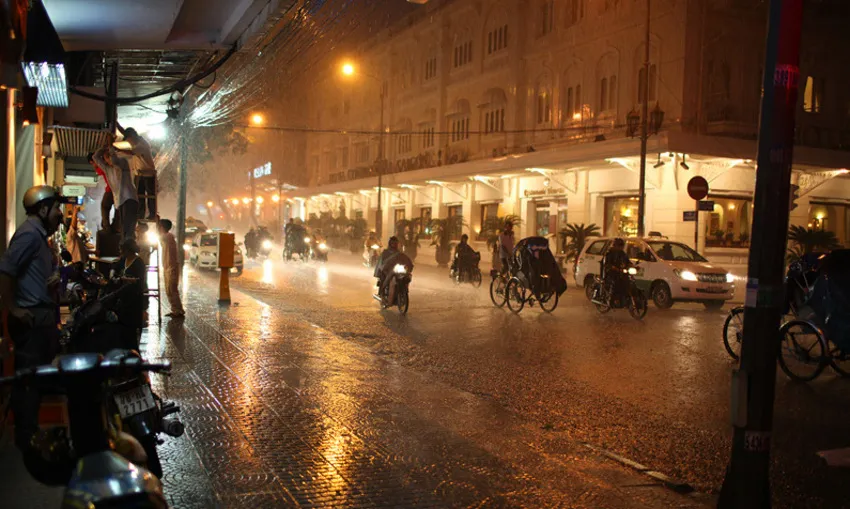
Mekong Delta: When the Rain Means Abundance
Rainy season overview: August - November. This is the main event: the "flood season" (mùa nước nổi). The rains cause the Mekong River to swell, flooding the fields and bringing an incredible abundance of fish, fruit, and life to the region.
Why you should go: This is, without a doubt, the most fascinating and vibrant time to visit. The delta transforms into a sprawling water world, and life moves onto the boats.
Must-do experiences:
- Explore Tra Su Cajuput Forest: This is a truly surreal experience. You'll be paddled through a vast forest submerged in water, covered by a thick, green carpet of duckweed. It's silent, beautiful, and utterly unique to this season.
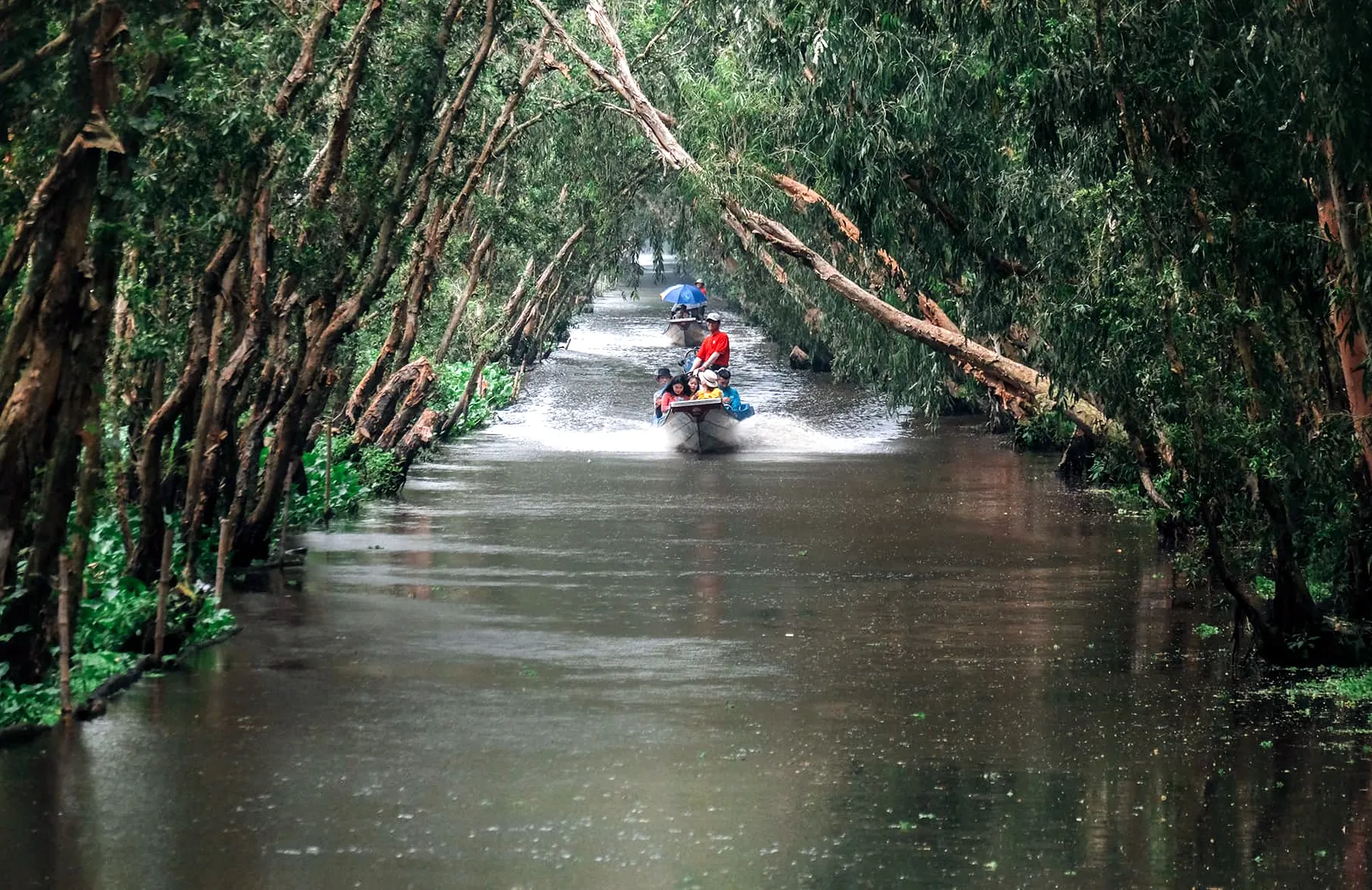
- Live on the water: Stay at a local homestay on one of the islets. You’ll not only sleep in a traditional home but also participate in daily life: catching fish in the flooded orchards, learning to cook local delicacies, and paddling a sampan through narrow, palm-fringed canals.
- Savor the taste of the season: The floating season brings special ingredients you can't get at other times. Be sure to try a hotpot made with cá linh (lady carp fish) and bông điên điển (sesbania flowers). It’s the authentic taste of the Mekong's bounty.
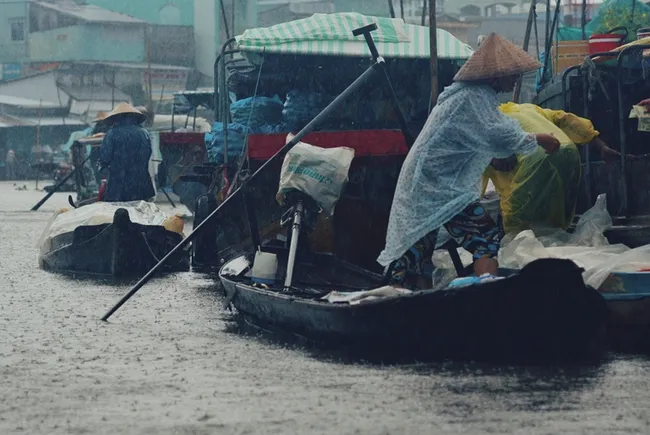
Red Flag Destinations: Travel with Extreme Caution
This section isn't meant to be alarmist, but realistic. Visiting these places during their peak rainy season carries significant risks.
Ha Giang & Sapa: The Perilous Beauty
The core risks: The primary risk is landslides. The winding mountain roads can become impassable or, worse, collapse. Fog can reduce visibility to near zero, making driving incredibly dangerous. What should be a stunning scenic drive becomes a stressful, high-risk endeavor. Trekking paths become thick, slippery mud, making for a miserable rather than enjoyable experience.
A safer approach: Travel in the shoulder months (May, early June, or late September). Hire the most experienced local guide and driver you can find. Add several buffer days to your itinerary in case you get stuck.
Ha Long Bay: A High-Stakes Gamble
The major drawbacks: The main rainy season (June - August) is also typhoon season. A single weather warning will cause the port authority to cancel ALL cruises, including overnight ones. You could arrive to find your pre-paid, non-refundable cruise is cancelled, throwing your entire northern Vietnam itinerary into chaos.
For the determined traveler: Book a cruise at the very last minute after checking the 5-day forecast. Have a complete backup plan for what you will do in Hanoi or Ninh Binh if the cruise is cancelled.
Nha Trang & Phu Quoc: The Beach Vacation That Isn't
What you're up against: The core appeal of these destinations is the beach and ocean. During their rainy seasons (Nha Trang: Oct-Dec; Phu Quoc: May-Oct), the sea is often violent, with large waves and strong currents. The water clarity is poor, making snorkeling or diving pointless. Many of Phu Quoc's famous West-coast beaches are plagued by trash washing ashore during this time. You're paying for a beach paradise but can't use the beach.
Your backup plan: In Phu Quoc, stay on the East coast (around Sao Beach), which is generally more sheltered. Focus on non-beach activities: visiting the Phu Quoc Prison museum, exploring pepper farms and fish sauce factories, and hiking in the national park.
The Ultimate Rainy Season Survival Guide
Preparation is everything. Pack smart, and you'll stay comfortable and safe.
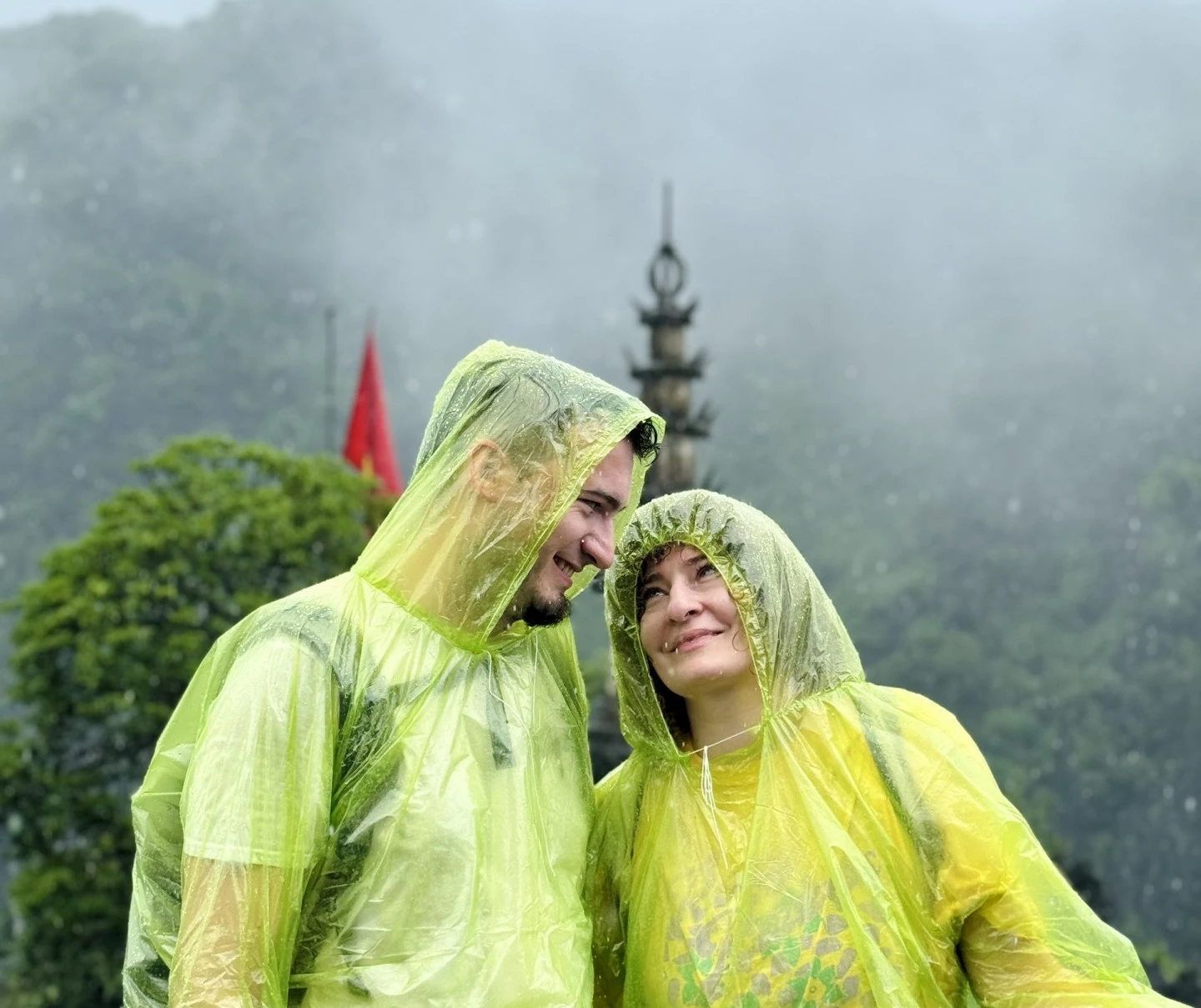
Your Waterproof Packing Checklist
Clothing:
- 3-4 quick-dry t-shirts/tops (synthetics or merino wool).
- 1-2 pairs of quick-dry trousers or shorts.
- What NOT to Pack: Jeans and heavy cotton. They take forever to dry and become heavy and uncomfortable when wet.
Footwear:
- A pair of high-quality waterproof walking shoes or trail runners.
- A pair of sturdy sandals with good grip (like Keens or Tevas) for walking in cities when it's wet.
Outerwear & gear:
- A lightweight but reliable waterproof and breathable jacket. This is your most important item.
- A travel umbrella for city use.
- A waterproof backpack cover or a dry bag to protect your electronics and passport.
Health & wellness:
- DEET-based insect repellent. Mosquitoes thrive in the wet season.
- A small quick-dry travel towel.
- Waterproof band-aids.
- Any personal medications.
Final Word: Embrace the Adventure
Traveling during the Vietnam rainy season is a choice. It’s a choice to trade guaranteed sunshine for guaranteed authenticity. It's for the traveler who finds beauty not just in a perfect sunset, but in the misty view from a café window. It’s for the adventurer who knows that sometimes, the most memorable stories come from the moments when things didn't go exactly as planned.
By choosing the right places and preparing with the right gear and mindset, you are setting yourself up for a trip that is not only more affordable and peaceful but also infinitely richer and more profound.
So pack that raincoat. But more importantly, pack your sense of wonder. You're about to experience a side of Vietnam that most tourists never get to see. Enjoy every drop.
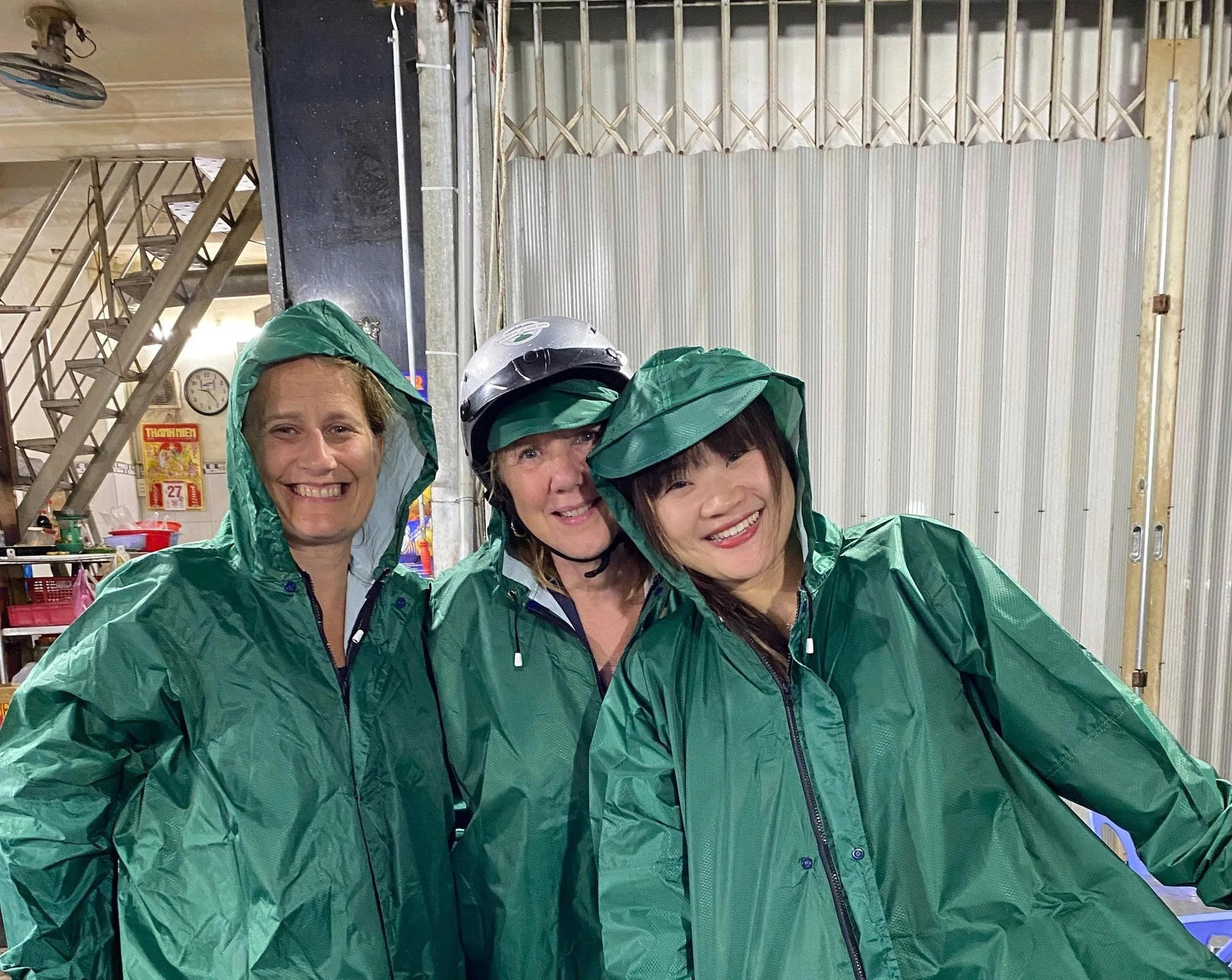
Anh Pham - General Manager
After exploring Ho Chi Minh City (or Saigon, as I love to call it) on a motorbike for over 10 years, these streets feel like my playground. I believe the best travel moments happen when you discover something unexpected. My goal is simple: to share my favorite parts of the city with you, so you can experience the real, everyday magic of my home.
Other tips
- Vietnam Flood Warning - Live Traveler Advisory & Safety Guide (Updated November 7, 2025)
- Halloween in Vietnam 2025: Saigon Special - Where to Go, What to Wear, and How to Slay the Night
- Ha Giang Loop: The Ultimate Guide to Planning Your 2025 Tour
- Vietnam Raining Season Guide: When to Go & What to Expect
- Top Things to Do in Hoi An
- What Souvenirs to Buy in Hanoi: 19+ Best Things to Buy (2025 Guide)
- Vietnam Visa for Australians 2025: A Complete Step-by-Step Guide
- Vietnam Itinerary for Small Group Travel: 10-Day Adventure Guide
- Traveling Alone in Vietnam: Best Solo Destinations, Activities & Safety Guide (2025)
- Vietnam’s Villages: A Deep Dive into their Hidden Charms
- Vietnam Reunification Day: What You Should Know About April 30th 2025

